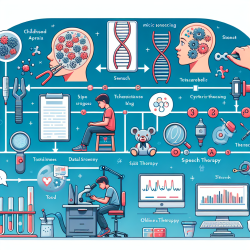Understanding CALFAN Syndrome and Its Implications for Speech-Language Pathologists
CALFAN syndrome, characterized by low ?-glutamyl transpeptidase (GGT) cholestasis, acute liver failure, and neurodegeneration, presents a unique set of challenges for medical professionals, including speech-language pathologists. The recent case report by Youssef et al. (2023) provides a comprehensive look at the syndrome's progression and management, offering valuable insights for practitioners aiming to improve therapeutic outcomes for affected children.
Key Findings from the Research
The study highlights a 23-year-old male patient with CALFAN syndrome who underwent liver transplantation after experiencing recurrent pediatric acute liver failure (PALF) and neurodegenerative symptoms. Despite the liver transplantation, the patient continued to exhibit neurocognitive difficulties, including developmental delays and speech impairments such as stuttering and limited expressive language.
One of the critical findings is the persistence of neurodegenerative symptoms even after liver transplantation. This highlights the importance of early and continuous intervention from speech-language pathologists to address speech and language impairments associated with the syndrome.
Implications for Speech-Language Pathology Practice
For speech-language pathologists, the research underscores several key considerations:
- Early Intervention: Given the early onset of neurocognitive symptoms, initiating speech and language therapy as soon as possible is crucial. Early intervention can help mitigate the impact of developmental delays and improve communication outcomes.
- Multidisciplinary Approach: Collaboration with a multidisciplinary team, including geneticists, neurologists, and hepatologists, is essential to address the complex needs of patients with CALFAN syndrome.
- Data-Driven Therapy: Utilizing data from ongoing assessments to tailor interventions to the specific needs of each child can enhance therapy effectiveness. Monitoring progress and adjusting strategies based on empirical evidence is vital.
- Family Involvement: Engaging families in the therapeutic process can provide additional support and reinforce strategies at home, contributing to better outcomes.
Encouraging Further Research
While the case report provides valuable insights, it also highlights the need for further research to understand the mechanisms underlying CALFAN syndrome fully. Speech-language pathologists are encouraged to contribute to this body of knowledge by documenting clinical observations, participating in interdisciplinary research, and exploring innovative therapeutic approaches.
Conclusion
Integrating the findings from the CALFAN syndrome case report into speech-language pathology practice can enhance the quality of care provided to affected children. By focusing on early intervention, collaboration, and data-driven decisions, practitioners can help improve communication outcomes and overall quality of life for these patients.
To read the original research paper, please follow this link: CALFAN (Low ?-Glutamyl Transpeptidase (GGT) Cholestasis, Acute Liver Failure, and Neurodegeneration) Syndrome: A Case Report with 3-Year Follow-Up after Liver Transplantation in Early Adulthood.










